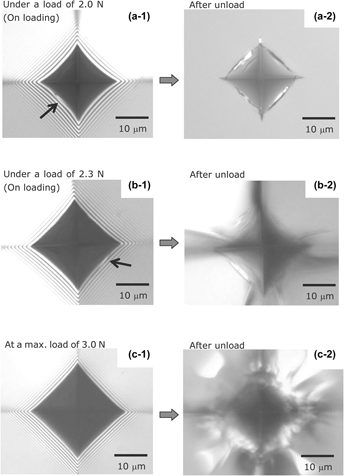Crossref Citations
This article has been cited by the following publications. This list is generated based on data provided by
Crossref.
Yoshida, Satoshi
Wada, Ken
Fujimura, Takahiro
Yamada, Akihiro
Kato, Mitsuo
Matsuoka, Jun
and
Soga, Naohiro
2016.
Evaluation of Sinking-In and Cracking Behavior of Soda-Lime Glass under Varying Angle of Trigonal Pyramid Indenter.
Frontiers in Materials,
Vol. 3,
Issue. ,
Pönitzsch, A.
Nofz, M.
Wondraczek, L.
and
Deubener, J.
2016.
Bulk elastic properties, hardness and fatigue of calcium aluminosilicate glasses in the intermediate-silica range.
Journal of Non-Crystalline Solids,
Vol. 434,
Issue. ,
p.
1.
Rouxel, Tanguy
and
Yoshida, Satoshi
2017.
The fracture toughness of inorganic glasses.
Journal of the American Ceramic Society,
Vol. 100,
Issue. 10,
p.
4374.
He, Zhenhua
Katsui, Hirokazu
and
Goto, Takashi
2017.
Mechanical properties of nano-grain SiO2 glass prepared by spark plasma sintering.
Journal of the European Ceramic Society,
Vol. 37,
Issue. 2,
p.
721.
Januchta, Kacper
Bauchy, Mathieu
Youngman, Randall E.
Rzoska, Sylwester J.
Bockowski, Michal
and
Smedskjaer, Morten M.
2017.
Modifier field strength effects on densification behavior and mechanical properties of alkali aluminoborate glasses.
Physical Review Materials,
Vol. 1,
Issue. 6,
Munawar Chaudhri, M.
2018.
Some concerns about the current interpretation and analyses of indentation unloading P – h curves highlighted with Young's modulus studies of single crystals of MgO (100).
Journal of Applied Physics,
Vol. 124,
Issue. 9,
p.
095107.
Januchta, Kacper
Sun, Ruofu
Huang, Liping
Bockowski, Michal
Rzoska, Sylwester J.
Jensen, Lars R.
and
Smedskjaer, Morten M.
2018.
Deformation and cracking behavior of La2O3-doped oxide glasses with high Poisson's ratio.
Journal of Non-Crystalline Solids,
Vol. 494,
Issue. ,
p.
86.
Varshneya, Arun K.
2018.
Stronger glass products: Lessons learned and yet to be learned.
International Journal of Applied Glass Science,
Vol. 9,
Issue. 2,
p.
140.
Mineta, Takahiro
Miura, Seiji
Oka, Kazuhiko
and
Miyajima, Tatsuya
2019.
Application of Modified Optical Indentation Microscopy as New <i>In Situ</i> Indentation Method.
MATERIALS TRANSACTIONS,
Vol. 60,
Issue. 8,
p.
1416.
Yoshida, Satoshi
Nguyen, Thu Huyen
Yamada, Akihiro
and
Matsuoka, Jun
2019.
<i>In-Situ</i> Raman Measurements of Silicate Glasses during Vickers Indentation.
MATERIALS TRANSACTIONS,
Vol. 60,
Issue. 8,
p.
1428.
Mound, B. A.
and
Pharr, G. M.
2019.
Nanoindentation of Fused Quartz at Loads Near the Cracking Threshold.
Experimental Mechanics,
Vol. 59,
Issue. 3,
p.
369.
Januchta, Kacper
and
Smedskjaer, Morten M.
2019.
Indentation deformation in oxide glasses: Quantification, structural changes, and relation to cracking.
Journal of Non-Crystalline Solids: X,
Vol. 1,
Issue. ,
p.
100007.
Luo, Jiawei
Grisales, William
Rabii, Matthew
Pantano, Carlo G.
and
Kim, Seong H.
2019.
Differences in surface failure modes of soda lime silica glass under normal indentation versus tangential shear: A comparative study on Na+/K+‐ion exchange effects.
Journal of the American Ceramic Society,
Vol. 102,
Issue. 4,
p.
1665.
Sung, Yongjin
Yoshida, Satoshi
Kato, Yoshinari
and
Kurkjian, Chuck
2019.
Three‐dimensional densification measurement of Vickers‐indented glass using digital holographic tomography.
Journal of the American Ceramic Society,
Vol. 102,
Issue. 10,
p.
5866.
Varshneya, Arun K.
and
Mauro, John C.
2019.
Fundamentals of Inorganic Glasses.
p.
187.
Cook, Robert F.
2019.
Fracture sequences during elastic–plastic indentation of brittle materials.
Journal of Materials Research,
Vol. 34,
Issue. 10,
p.
1633.
Gerbig, Y.B.
and
Michaels, C.A.
2020.
In-situ Raman spectroscopic measurements of the deformation region in indented glasses.
Journal of Non-Crystalline Solids,
Vol. 530,
Issue. ,
p.
119828.
Mineta, Takahiro
Miura, Seiji
Oka, Kazuhiko
and
Miyajima, Tatsuya
2020.
Application of Modified Optical Indentation Microscopy as New <i>In Situ</i> Indentation Method.
Journal of the Japan Institute of Metals and Materials,
Vol. 84,
Issue. 4,
p.
128.
Kasimuthumaniyan, S.
Reddy, Allu Amarnath
Krishnan, N.M. Anoop
and
Gosvami, Nitya Nand
2020.
Understanding the role of post-indentation recovery on the hardness of glasses: Case of silica, borate, and borosilicate glasses.
Journal of Non-Crystalline Solids,
Vol. 534,
Issue. ,
p.
119955.
Liu, Pengfei
Youngman, Randall E.
Jensen, Lars R.
Bockowski, Michal
and
Smedskjaer, Morten M.
2020.
Achieving ultrahigh crack resistance in glass through humid aging.
Physical Review Materials,
Vol. 4,
Issue. 6,
